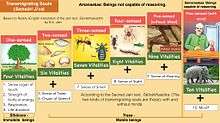Vitalism (Jainism)
| Part of a series on |
| Jain philosophy |
|---|
 |
| Concepts |
|
| People |
|
Vitalism is at the core of Jain philosophy which separates Jiva (soul or life) from Ajiva (non-soul). According to Jain cosmology, whole universe is made up of six simple substances and is therefore eternal. These six substances (dravya) are:-
Jiva or soul is distinguished from the rest five (termed Ajiva) on account of the quality of intelligence with which it is endowed and of which the other substances are devoid.
Overview

According to Jainism, there are ten vitalities or life-principles:-
- The five senses
- Touch
- Taste
- Smell
- Sight
- Hearing
- Energy,
- Respiration
- Life-duration
- The organ of speech
- The mind
The table below summarizes the vitalities that living beings possess in accordance with their senses.[2]
| Senses | Number of vitalities | Vitalities |
|---|---|---|
| One sense | Four | Sense organ of touch, strength of body or energy, respiration, and life-duration. |
| Two sense | Six | The sense of taste and the organ of speech in addition to the former four. |
| Three sense | Seven | The sense of smell in addition to the former six. |
| Four sense | Eight | The sense of sight in addition to the former seven. |
| Five-sensed beings |
Nine | The sense of hearing in addition to the former eight. |
| Ten | Mind in addition to the above-mentioned nine vitalities. |
According to major Jain text, Tattvarthsutra: "The severance of vitalities out of passion is injury".
Because life is to be considered sacred and in every living thing, Jains avoid killing any living creature. They are not only vegetarian, but decline to eat vegetables that grow under the ground, for fear of injuring a living thing when disturbing the ground during harvest. Often Jain monks will sweep the ground in front of them as they walk so as not to step on an unseen creature.
See also
References
- ↑ Jain 1960, p. 62-63.
- ↑ S.A. Jain 1992, p. 62–63,196.
References
- Pujyapada (Shri.) (1960). S. A. Jain, ed. Reality. Vira Sasana Sangha. Archived from the original on 2015.
 This article incorporates text from this source, which is in the public domain.
This article incorporates text from this source, which is in the public domain.